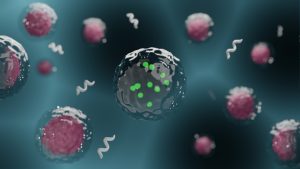Nanorobotics: Studying and engineering collective motion at the nanoscale in (bio)-fluidic environments

We have developed of a versatile system of motile colloids, which is of current fundamental (active matter, soft matter physics) and technological (microfluidics, biophysics, drug delivery) interest. The experimental system is based on helical magnetic nanostructures (/nanoswimmers) dispersed in fluidic environments, maneuvered by rotating/oscillating magnetic fields. Our group has made important contributions in understanding and expanding the scope of this powerful nano-system, and this research has also led to a start-up in the field of medical nanodevices.
We carried out detailed experimental study of the dynamics of the nanoswimmers, performed numerical simulations, and derived analytical formulae that explain the picture accurately. Crucially, this has led to a technology to measure mechanical properties (viscosity) of complex (e.g. shear thinning) and heterogeneous fluidic environments with sub-micron spatial resolution and high speed. In collaboration with biologists, we investigated the toxicity of the swimmers, integrated therapeutic potential, and engineered the system to be suitable for in vivo applications. The start-up from our group builds upon the therapeutic potential of the swimmers in domain of dentistry and will soon be extended to cancer therapeutics. The swimmers could be rendered self-propelled under appropriate magnetic drive, which has resulted in the development of a novel artificial active matter system. We demonstrated the structures can be maneuvered inside living cells with exquisite spatial control, where intracellular manipulation had zero adverse effect on cellular viability, but instead the motion was a strong function of the mechanical microenvironment inside the cell.
A major aim in our immediate future is to demonstrate therapeutic potential of magnetic nanoswimmers under in vivo conditions (in mice), with specific goals in the areas of dentistry and cancer therapy. In this regard, we have recently devised a new strategy toward targeting cancer cells in tissue-like environments under ex vivo conditions. These efforts are on their way to be tried in live mice, and within next few years we hope to complete some of the regulatory questions related with this new therapeutic system: long and short-term toxicity, bio-distribution, deep tissue imaging etc. These highly applied efforts will be complemented with fundamental studies of their collective dynamics and swarm behavior, especially how to engineer a collection of motile “fantastic voyagers” to achieve the envisioned tasks. Our dream is to reach clinical trials with this novel therapeutic strategy within the next few years. On a parallel effort we are pursuing right now, the swimmers have been integrated with quantum sensing (N-V centers) properties, which offer a unique probe as sensing and perturbing agents in biophysical processes (both intracellular and extracellular), in a spatiotemporal scale that has never been studied. Development of this unique toolbox for biophysical studies will be another one of our major goals over next five years.
